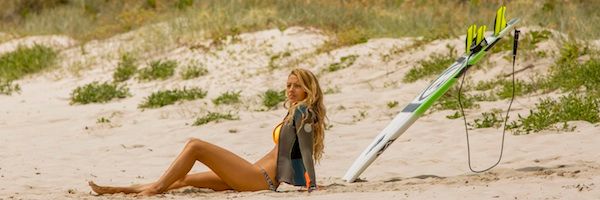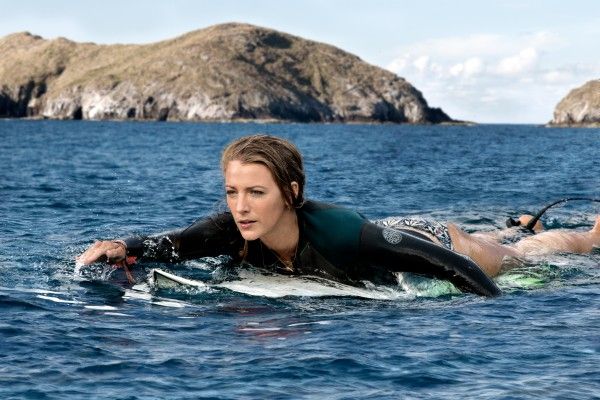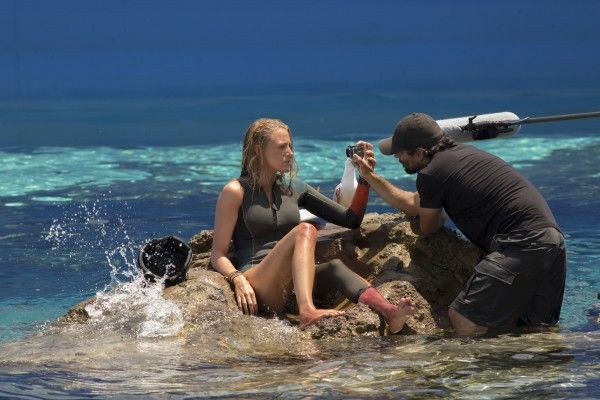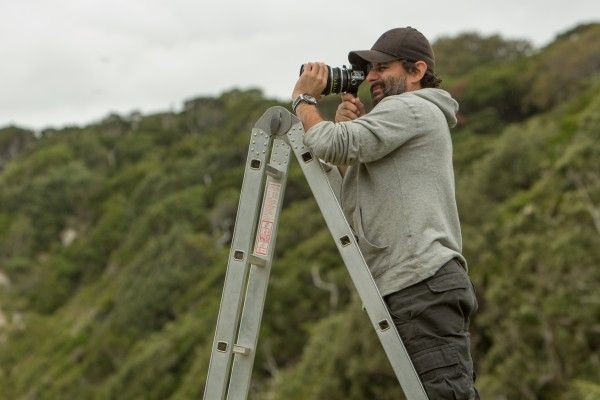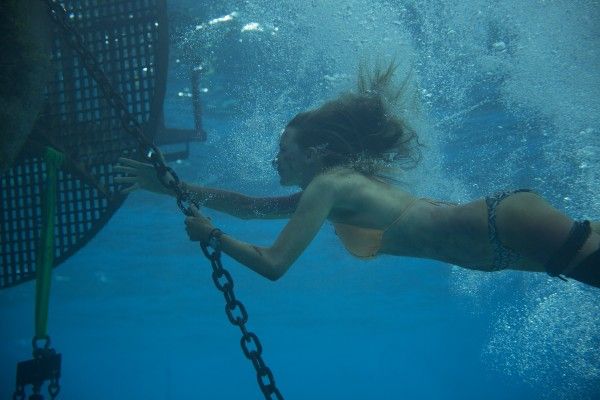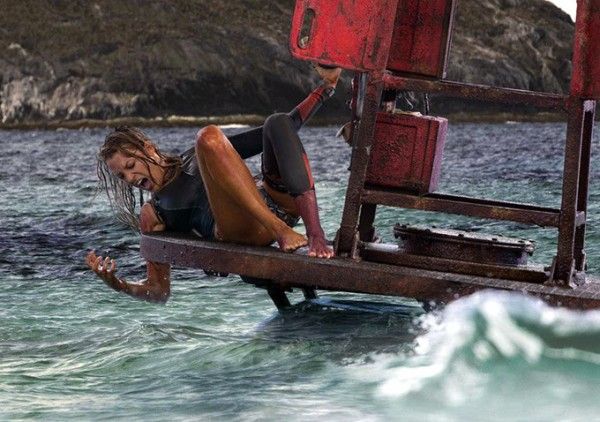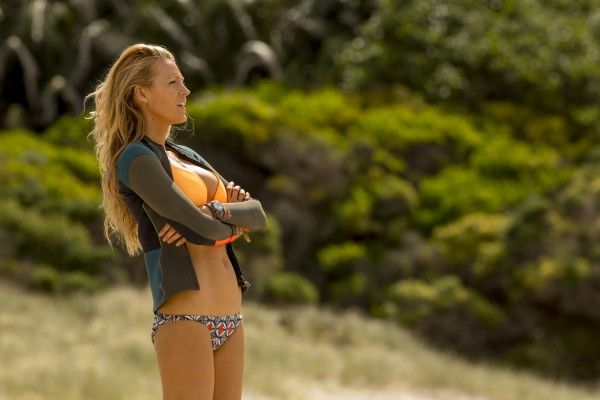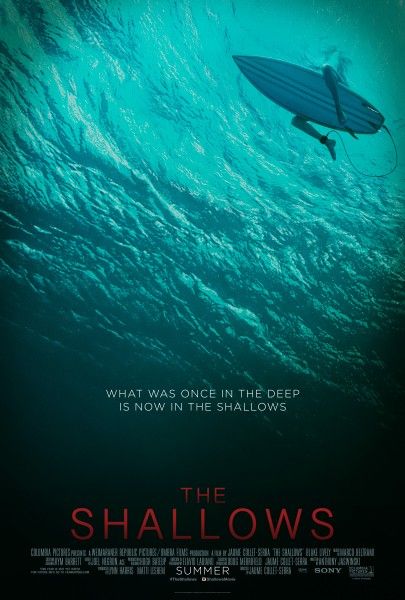In the simplest terms, The Shallows is Blake Lively vs. a shark. It's a fun film that had one of the best marketing campaigns of the summer (including some marvelous and unique trailers) and is given extra layers from director Jaume Collet-Serra (Non-Stop, The Orphan) who films the movie as a pop song combination of the two genres he's most dabbled in: thriller and horror.
In a summer that's been treading water without a bonafide hit (apart from sequels), The Shallows has already recouped it's entire budget of $17 million, after moving its release date up a few days (from June 29 to June 24). Word of mouth will determine how long it'll last in the pool, but the surfer stranded on a rock at an un-patrolled, hard to find beach, has already beaten expectations.
Last week, I got to sit down with Collet-Serra to discuss the challenging aspects of the shoot—such as creating the shark, casting the role of the woman who spends most of the time alone on screen, and the injured seagull that steals some scenes from her. Collet-Serra really wanted to make a colorful summer movie. I think he and Lively both succeeded admirably, but sound off in the comments with your (spoiler-free) thoughts.
Can you elaborate on how The Shallows was re-tailored to fit Blake Lively's strengths?
JAUME COLLET-SERRA: When I came on board, I fell in love with the possible challenges of shooting it, and I liked the idea of making of a young summer movie, which is actually something that is becoming very rare.
But I didn't necessarily fall in love with the character from the first read of the script. So that was always open for discussion. And we knew that we would find the actor that would really have a big influence, because it’s much smarter to cast somebody and then write for that person, when there’s only one person in the movie. It’s very different when there’s 20 parts vs one part. If you have 20 roles you can cast who best fits from the start, but with a movie like this you'll have to change the character to best fit your actor. Blake (Lively) is smart, she’s tough, she’s capable. So the character had to be smart, tough, and capable. In a way it made it much better because you want that person to go through that. By going a few years older than originally written it became different, you know? With Blake we could make Nancy somebody who had just quit medical school but is almost a doctor, and is very smart, so she's able to take her earrings and suture herself That was not in the original script. That’s part of the character. When you have somebody who’s smart and capable, you can do things that are much more interesting.
Was the character originally younger?
COLLET-SERRA: Yes.
How much younger?
COLLET-SERRA: Three or four years, but it's more than the number. Obviously, Blake is a mom, it’s not a question of age, it’s a question of maturity. The younger character in the original script was more immature. But you cannot make Blake immature, because Blake has never been immature, you know? She’s been a strong human being for a long time, so you have to make the character mature. I think that she's also very spiritual. I think she’s a great role model, and young people, young girls are going to see the movie and feel inspired by her. I hope.
Something I liked from the beginning was your functional use of her cell phone. Because a lot of thrillers or horror movies, they have to use the phone in a way so you know why it’s not available to help them. They lost service, it felt, the battery died, etc. But you use her cell phone as a way to get to know Nancy better.
COLLET-SERRA: It’s very difficult. It’s incredibly difficult. If you do any thriller or horror movie a big part of the process is accounting for the cell phone. It's made storytelling very different. The idea was—and it was always storyboarded like this—that we would only use inserts of pictures and FaceTime moments, because I never wanted to leave the beach. I feel that if you leave the beach, and physically visit her family in Galveston, Texas, and put the audience there, then you have to cit back to it. Once she’s gone, the audience will expect you to cut back to Galveston, Texas, and give her father and sister a bigger worrying presence: Have you heard from her? Where is she?
Once you introduce that point of view, you cannot take it away from the audience. So that’s why we had to come up with a way to stay in the beach. It’s tough, it’s a tough decision. It was a big internal debate that I had. But isolating Nancy was necessary because she is isolated and alone in this situation. I think I made the decision that, at the end, was smarter for the movie. Whether it pays off or not, we’ll see.
When she's surfing, there’s party music, and summer vibes, but when the camera follows the wave down into the ocean it goes away. It's a touch I really liked, how many different musical cues did you play around with there?
COLLET-SERRA: The thematic idea is that they’re playing in an environment that does not belong to them. They’re fun in an environment, but they are disturbing what's underneath. Not that they shouldn’t be there, but they feel like the kings of the world, and yet the world is bigger than they are thinking in that moment of their surface fun. That’s why cutting the sound there and cutting the music was the logical thing. Because underneath the water, it’s not a party. Whatever’s out there, the fish, the turtle, whatever, they don’t care that these kids are partying, and that really created the sense.
I didn’t wanna just have a two-minute music video montage. So the first time I tried it, I tried it with no fun music, just a score (from the film's composer Marco Beltrami). But the reality was, even though the images were beautiful, we didn’t really have the energy that I think it kinda needs to have for the movie. So I came up with the idea of this change of perspective, blasting some music and then dropping it out. I think it makes the audience lean forward, and be like, “what’s going on?” And I think that that’s interesting.
It’s a respectful fear of the ocean, because everything underneath is its own separate universe.
COLLET-SERRA: And that’s why I think I could make this movie so bright in color. When you make a thriller/horror, darkness is [your] friend, because it lets the imagination go wild and what not. So you always end up going into darkness. But here you can get as bright as you want because under the water is always gonna be darker. You can be happy up there, visually, but dark underneath. That was a breath of fresh air, visually, for me, to work with that part.
How arduous was it creating the shark?
COLLET-SERRA: You just cross your fingers and hope for the best. The best way to do it, in theory, is to have a physical thing that interacts with the water when you're shooting, as similar to a shark as possible. How far do you go? Do you build a mechanical shark? And that the realities are that the bigger that you build, the more difficult it is to move, so it defeats the purpose. So we just created different physical elements. We made a fin, the tail that we could interact with water, and then replace those things with CG. But when you're first editing, you just see divers splashing holding these objects, or things like that for months, and one day you have a bit of a shark that comes in grayscale, and you’re like, “Is that how it’s gonna look?’ and they’re like ‘No, we’re gonna keep working on it.’ And eventually it gets better, but until a week ago, I didn’t even know. It’s at the very end of the process that you see, almost last minute. Finally the movie comes together.
And what about "Steven Seagull"? The real seagull. How long does it take to cast a seagull and get it to do what you want it to do?
COLLET-SERRA: We didn't want CG. Or I didn't. Definitely. We wanted to use [a seagull] that had maybe been injured on the wing as well beforehand, so we found some in captivity, but we really lucked out because this seagull was a genius seagull. There was minimal training, really, because he was so good. He knew when to look at the camera. When to look at Blake. People definitely thought it was crazy to have a real seagull but it ended up being one of the easiest things we could've done. And I think the movie is better for it.
I know you said maturity, but what were the qualities that made you cast Blake?
COLLET-SERRA: I think that she was really excited to do it, particularly the physicality, and at the end of the day as a director, you wanna find a partner who really believes in the movie. [For] something like this, we had to find somebody who’s 150 percent passionate about it, and she was. She wanted to help, she wanted to absolutely help. For one day, you put me on that rock or in the tank, after one day I would be dead [laughs]. You know how hard it is to swim take after take and perform the next day swimming again? Me, I'm a terrible swimmer, but most actors with that tight schedule would be sick pretty quick. She wasn’t sick a single day. Even when she at the crab, she didn't get sick.
She actually ate that [spider] crab?
COLLET-SERRA: Yeah. We needed something to show that she was taking care of herself first. Blake and I talked about it, we liked having the seagull and she's a very mature, strong woman, but we didn't want her to become Mother Theresa. We needed a beat to show that, while she is selfless, she does have herself as her first priority.
What were you pursuing in this film that was maybe different than the rest of your filmography?
COLLET-SERRA: A lot of things. I think that creating such a character was one. Working in an open, bright environment [was] another, and doing a movie for younger people. Most of my movies are rated R, and are much darker. It’s completely different. I think that it’s funny, because to promote this movie, they don’t even mention my movies with Liam Neeson, because they’re so different. They mention my movies like House of Wax, and The Orphan that I did earlier on in my career. So in marketing terms, I have my horror career, and my thriller career. I suppose this is closer to the earlier part of my career, except with very bright visuals, so it's different.
I'd say this nicely combines both thriller and horror.
COLLET-SERRA: Thank you. I hope so. I can't over-emphasize the importance of the colors and energy for me, though. This is a summer movie, distinctly. And that's very exciting for me to be able to make it.
The Shallows is currently in theaters and will expand further on Wednesday, June 29.
In the taut thriller The Shallows, when Nancy (Blake Lively) is surfing on a secluded beach, she finds herself on the feeding ground of a great white shark. Though she is stranded only 200 yards from shore, survival proves to be the ultimate test of wills, requiring all of Nancy’s ingenuity, resourcefulness, and fortitude.

